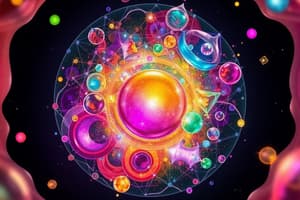Podcast
Questions and Answers
Which of the following is considered a pure substance?
Which of the following is considered a pure substance?
- Milk
- Soil
- Salt (correct)
- Ghee
A mixture can be separated by physical processes.
A mixture can be separated by physical processes.
True (A)
What is a homogeneous mixture?
What is a homogeneous mixture?
A mixture that has a uniform composition throughout.
What distinguishes a heterogeneous mixture from a homogeneous mixture?
What distinguishes a heterogeneous mixture from a homogeneous mixture?
A pure substance consists of a single type of ____________.
A pure substance consists of a single type of ____________.
Which of the following is an example of a heterogeneous mixture?
Which of the following is an example of a heterogeneous mixture?
What is the characteristic of a pure substance?
What is the characteristic of a pure substance?
A solution of salt in water is an example of a ____________ mixture.
A solution of salt in water is an example of a ____________ mixture.
Flashcards are hidden until you start studying
Study Notes
Understanding Purity of Matter
- Pure substances consist of only one type of particle and maintain the same chemical composition throughout.
- Common consumable items like milk, ghee, butter, and juices are considered mixtures rather than pure substances due to their multiple components.
- Mixtures can be categorized based on the nature of their constituents as either homogeneous or heterogeneous.
Types of Mixtures
- Homogeneous Mixtures (Solutions): Components are uniformly distributed, resulting in consistent appearance and composition. Examples include:
- Salt dissolved in water
- Sugar dissolved in water
- Heterogeneous Mixtures: Composed of visibly different substances or phases. These mixtures lack uniformity in composition. Examples include:
- Sand and iron filings
- Oil and water
- Mixtures can vary in composition, even within homogeneous mixtures, as demonstrated by varying intensities of color in solutions.
Key Concepts Related to Mixtures
- A pure substance retains the same characteristic properties regardless of its source.
- Mixtures contain two or more pure components and can be separated by physical methods, such as filtration, evaporation, or centrifugation.
- The recognition of pure and impure substances is crucial, as the term “pure” for scientists signifies a single type of particle rather than a lack of adulteration.
Studying That Suits You
Use AI to generate personalized quizzes and flashcards to suit your learning preferences.




